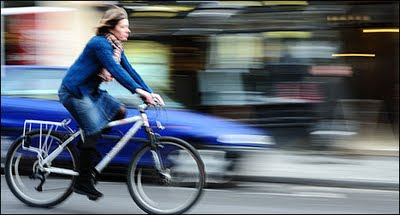
Long Beach, CA: One way to make a street “complete” is to create bicycle lanes in which people of any age or ability can feel safe. From la.streetsblog.org.
Another step toward transforming our streets was taken last week in Richmond city council. Our representatives unanimously approved a Complete Streets policy. It didn’t get much if any attention in the mainstream press, but this is yet another measure that signals clearly that we’re moving — if still a bit slowly — in the right direction.
What is a Complete Streets Policy?
As worded in the policy (full text here) adopted on October 13:
Complete Streets are designed and operated to safely accommodate street users of all ages and abilities, including pedestrians, bicyclists, transit passengers, and motorists.
Complete Streets policies serve, in essence, to rebalance the approach taken to street (re)design to give all of those users not in cars a fair shake. In most U.S. cities for the last few decades the main focus has been accommodating cars. Prioritizing the efficiency and convenience of car travel did a lot to discourage other forms of transportation — and made a lot of cities less inviting in general. Suburban areas with multi-lane, highway like arterial roads — without sidewalks or bike lanes — are the epitome of this, but even in downtown Richmond there are plenty of places where it’s just not pleasant or safe to walk or bike.
So now, in technical terms, the manual that Richmond’s traffic engineers and planners use when they are doing anything to a street has to be revised to ensure a better balance. This is especially important in Richmond because some of the people making decisions about such things have yet to fully embrace the idea of shifting priority away from cars.
Battling Misconceptions and Motorist Privilege
Changing Richmond’s streets is clearly a long-term process — as is changing the culture that shapes how we see and use our streets. There can be a good bit of animosity between “us” and “them” — usually car drivers versus people who bicycle. Some things that bicyclists do contribute to that tension, but a lot of it comes from the fact that motorists are used to being the privileged majority.
That helps explain why Complete Streets policies and bike lanes are sometimes interpreted as anti-car; anything that questions or limits what has otherwise been the overwhelming dominance of cars looks like an attack on driving in general. If you look at how much money and space is still being allocated to cars, it’s hard not to chuckle (or sigh) at the anger sometimes provoked by giving a bit more priority to others.
That’s why I was so pleased to read Phil Riggan’s retorts to a range of, well, let’s say “somewhat misinformed” responses to a recent “Why, Richmond, Why?” piece dealing with bicyclists’ and motorists’ gripes about each other. Apparently Riggan got a proverbial ear full in response, and at least a few of them show signs of what I’m calling “motorist privilege.” In the follow-up he does a very nice job of pointing out some of the skewed reasoning that this engenders.
A lot of it boils down to complaints about bicyclists doing “illegal” things that are actually not illegal (and are in some cases done for the cyclist’s own safety), blaming cyclists for unsafe conditions that they did not create, and — this is my favorite — cluttering up the city with their parked bicycles (!). Riggan’s response to the latter:
One more complaint, a reader can’t stand all the bikes locked up on sidewalks, blocking pedestrian walkways. Ahem. Cars. Are. Parked. Everywhere. I must ask, where else should the bikes be parked? Dark alleyways? Richmond needs plenty more places to lock up a bike (yes, we need to lock them to something, not just parked on the side of the street).”
Add to that the fact that you can park about 10 bicycles in the same space required by the average car. Never mind the incredibly expensive parking decks that also generally create dead space in what could otherwise be a lively street.
Some cyclists in Latvia recently came up with a very creative way to show just how much space cars take up on the road and elsewhere compared to bicycles (see article here):

From designboom.com.
Just imagine how much nicer our city would be if we didn’t have to devote so much space for car parking and wide streets. With the right infrastructure, bicycling, walking, and mass transit could be just as convenient if not more so than driving. Hopefully we can make sure that the Complete Streets policy translates into streets that truly have space for everyone.




